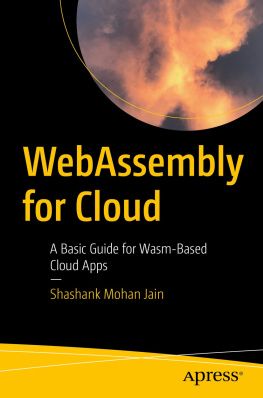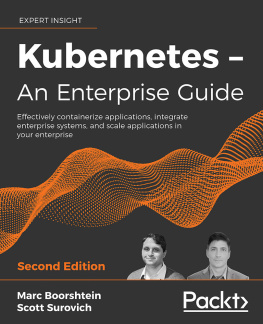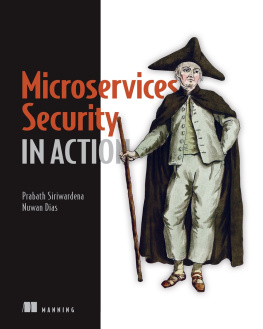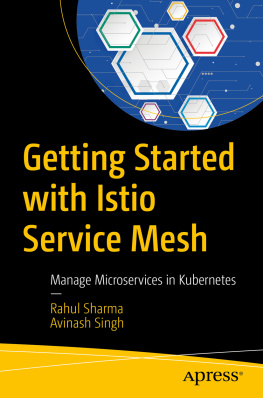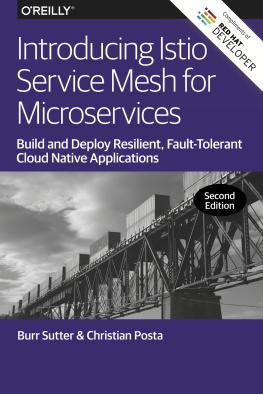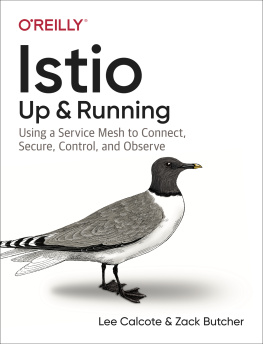Rinor Maloku - Istio in Action
Here you can read online Rinor Maloku - Istio in Action full text of the book (entire story) in english for free. Download pdf and epub, get meaning, cover and reviews about this ebook. year: 2022, publisher: Manning Publications, genre: Home and family. Description of the work, (preface) as well as reviews are available. Best literature library LitArk.com created for fans of good reading and offers a wide selection of genres:
Romance novel
Science fiction
Adventure
Detective
Science
History
Home and family
Prose
Art
Politics
Computer
Non-fiction
Religion
Business
Children
Humor
Choose a favorite category and find really read worthwhile books. Enjoy immersion in the world of imagination, feel the emotions of the characters or learn something new for yourself, make an fascinating discovery.
- Book:Istio in Action
- Author:
- Publisher:Manning Publications
- Genre:
- Year:2022
- Rating:4 / 5
- Favourites:Add to favourites
- Your mark:
- 80
- 1
- 2
- 3
- 4
- 5
Istio in Action: summary, description and annotation
We offer to read an annotation, description, summary or preface (depends on what the author of the book "Istio in Action" wrote himself). If you haven't found the necessary information about the book — write in the comments, we will try to find it.
Istio in Action — read online for free the complete book (whole text) full work
Below is the text of the book, divided by pages. System saving the place of the last page read, allows you to conveniently read the book "Istio in Action" online for free, without having to search again every time where you left off. Put a bookmark, and you can go to the page where you finished reading at any time.
Font size:
Interval:
Bookmark:

Christian E. Posta, Rinor Maloku
Foreword by Eric Brewer
To comment go to liveBook

Manning
Shelter Island
For more information on this and other Manning titles go to
www.manning.com
For online information and ordering of these and other Manning books, please visit www.manning.com. The publisher offers discounts on these books when ordered in quantity.
For more information, please contact
Special Sales Department
Manning Publications Co.
20 Baldwin Road
PO Box 761
Shelter Island, NY 11964
Email: orders@manning.com
2022 by Manning Publications Co. All rights reserved.
No part of this publication may be reproduced, stored in a retrieval system, or transmitted, in any form or by means electronic, mechanical, photocopying, or otherwise, without prior written permission of the publisher.
Many of the designations used by manufacturers and sellers to distinguish their products are claimed as trademarks. Where those designations appear in the book, and Manning Publications was aware of a trademark claim, the designations have been printed in initial caps or all caps.
Recognizing the importance of preserving what has been written, it is Mannings policy to have the books we publish printed on acid-free paper, and we exert our best efforts to that end. Recognizing also our responsibility to conserve the resources of our planet, Manning books are printed on paper that is at least 15 percent recycled and processed without the use of elemental chlorine.
| Manning Publications Co. 20 Baldwin Road Technical PO Box 761 Shelter Island, NY 11964 |
Development editor: | Elesha Hyde |
Technical development editor: | Brent Stains |
Review editor: | Aleksandar Dragosavljevi |
Production editor: | Andy Marinkovich |
Copy editor: | Tiffany Taylor |
Proofreader: | Jason Everett |
Technical proofreader: | Gregory Reshetniak |
Typesetter and cover designer: | Marija Tudor |
ISBN: 9781617295829
I dedicate this book to my wife and daughters.
Christian Posta
I dedicate this book to everybody who shares knowledge on the web.
Rinor Maloku
A service mesh can maximize the development speed of your whole organization by enabling thousands of independent microservices that are automatically compliant with a wide range of evolving policies. This book discusses many other benefits of Istio, but they largely follow from this premise.
This brings us to the central question, What is a service mesh, and why do I need one? Im asked this question frequently, and the answer is not trivial. It is not about security or telemetry or most of the benefits some people claim. Nor is it automatically the case that you need a service mesh for your application, especially if it is a monolith.
The real answer has to do with decoupling applications from infrastructure. Istio is the third major step in that direction. First, Docker provided a way to package an application (and its library choices) separately from the machine on which it runs. Next, Kubernetes made it easy to create a service with automation to help with autoscaling and management. Together, Docker and Kubernetes enabled the practical movement to fine-grain services, often called microservices. This book guides you through implementing a service mesh with Istio to achieve this third step: application decoupling.
Microservices allow greater overall velocity by enabling teams to be more autonomous. Ideally, your team can update its microservice(s) without deep interactions with other teams. The top-level goal for Istio is to enable this at scaleto make it easy to have thousands of microservices (Google has more than a million!).
But enabling velocity for a service is not just about decoupling it from the machine; the service must also be decoupled from shared policies. Every enterprise has policies that apply to all services, and we must be able to change those policies quickly if needed. Traditionally, such policies are embedded inside services as part of the code or as libraries that services are expected to use. Either way, such policies are hard to update and enforce.
Istio moves a wide range of such policies (primarily those involving an API) out of the service and into the service mesh, which is essentially a proxy that sits in front of the service and implements the policies. When this is done correctly, all services meet the policies with no workand, conversely, policy changes do not require updating the services. This is the decoupling we are after.
In Istio in Action, Christian and Rinor present a clear-headed vision of how to achieve the goal of decoupling applications from infrastructure. I hope youll enjoy this book as much as I have.
Eric Brewer, VP Infrastructure and Google Fellow
Building software is hard. Connecting different services across a network is harder. Any time you put a packet, message, or request on the network, there are no guarantees about its outcome. Will the request make it? How long will it take? Will anyone know if the communication fails?
Docker and Kubernetes have done a lot to support distributed services architectures like microservices, but they exacerbate the existing communication problems. One misbehaving service might take down everything.
While working with organizations worldwide that are trying to adopt microservices, I find that getting teams to consistently think about and solve these communication problems is very difficult. There are many questions: How will they do service discovery? Timeouts? Retries? Circuit breaking? Tracing? Authentication? Large cloud companies like Netflix, Twitter, and Google pioneered some of the early, successful microservices architectures. These companies had to build a lot of their own developer tooling and infrastructure to solve these problems, and fortunately, they open sourced much of it. Could other organizations use the NetflixOSS stack or Twitter Finagle? They could, and some did, but doing so created a new operational nightmare.
For example, the NetflixOSS stack was primarily written for Java developers. What about NodeJS, Golang, and Python teams? Teams had to either build libraries themselves or hack together the functionality with various bits they found on the internet. They also had to intermingle this networking code into their business logic. This approach added transitive dependencies, cluttered the code, and made revisions more difficult. Operating a service architecture with these application networking libraries, upgrading, patching, and doing this consistently across many different languages was extremely complex and error prone.
A service mesh is a cleaner solution to this application-networking problem. With a service mesh, we abstract away the application-networking logic into a dedicated piece of infrastructure and apply it to all services regardless of what languages they are written in.
Istio is a scalable, mature, powerful service-mesh implementation that originally came out of a project from IBM and Google. I was introduced to the Istio team in January 2017 and began working on the project very early. At the end of 2018, I went to work as global field CTO at a startup, Solo.io, to focus full-time on service mesh technology and advancing the state of application networking.
Font size:
Interval:
Bookmark:
Similar books «Istio in Action»
Look at similar books to Istio in Action. We have selected literature similar in name and meaning in the hope of providing readers with more options to find new, interesting, not yet read works.
Discussion, reviews of the book Istio in Action and just readers' own opinions. Leave your comments, write what you think about the work, its meaning or the main characters. Specify what exactly you liked and what you didn't like, and why you think so.



